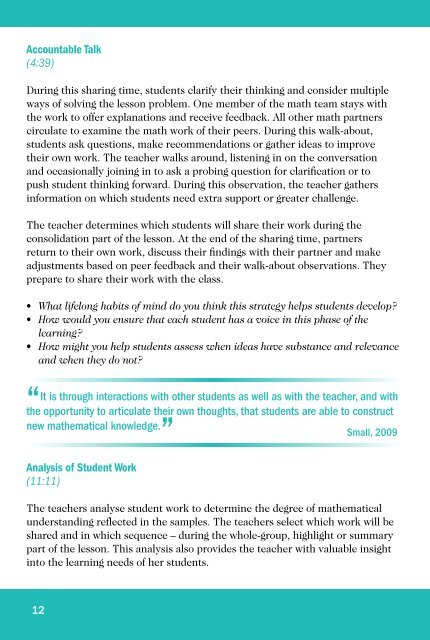Teaching Mathematics Through a Social Justice Lens Viewer's Guide
Teaching Mathematics Through a Social Justice Lens Viewer's Guide
Teaching Mathematics Through a Social Justice Lens Viewer's Guide
Create successful ePaper yourself
Turn your PDF publications into a flip-book with our unique Google optimized e-Paper software.
Accountable Talk<br />
(4:39)<br />
During this sharing time, students clarify their thinking and consider multiple<br />
ways of solving the lesson problem. One member of the math team stays with<br />
the work to offer explanations and receive feedback. All other math partners<br />
circulate to examine the math work of their peers. During this walk-about,<br />
students ask questions, make recommendations or gather ideas to improve<br />
their own work. The teacher walks around, listening in on the conversation<br />
and occasionally joining in to ask a probing question for clarification or to<br />
push student thinking forward. During this observation, the teacher gathers<br />
information on which students need extra support or greater challenge.<br />
The teacher determines which students will share their work during the<br />
consolidation part of the lesson. At the end of the sharing time, partners<br />
return to their own work, discuss their findings with their partner and make<br />
adjustments based on peer feedback and their walk-about observations. They<br />
prepare to share their work with the class.<br />
• What lifelong habits of mind do you think this strategy helps students develop?<br />
• How would you ensure that each student has a voice in this phase of the<br />
learning?<br />
• How might you help students assess when ideas have substance and relevance<br />
and when they do not?<br />
“<br />
It is through interactions with other students as well as with the teacher, and with<br />
the opportunity to articulate their own thoughts, that students are able to construct<br />
new mathematical knowledge. ” Small, 2009<br />
Analysis of Student Work<br />
(11:11)<br />
The teachers analyse student work to determine the degree of mathematical<br />
understanding reflected in the samples. The teachers select which work will be<br />
shared and in which sequence – during the whole-group, highlight or summary<br />
part of the lesson. This analysis also provides the teacher with valuable insight<br />
into the learning needs of her students.<br />
12

















